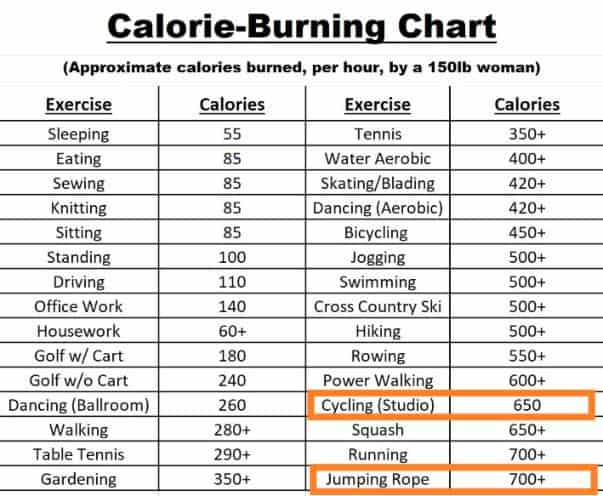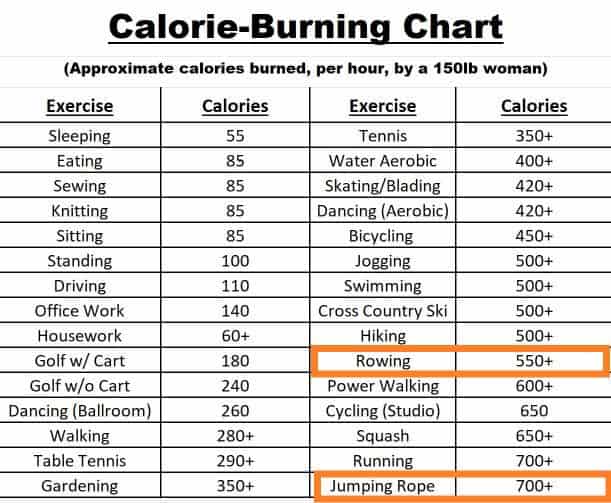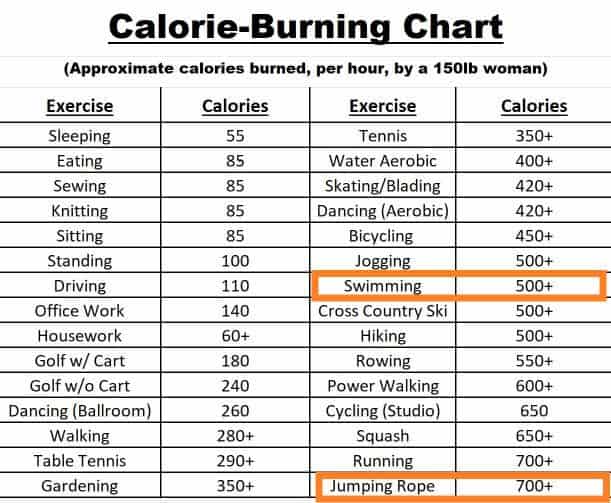We’re taking a look at all the major cardio exercises and how they compare to jumping rope. From calories burned and muscles worked, to any potential downsides, like risk for injury. It’s all here.
This piece is meant to be 100% objective, exploring all the pros and cons, including those of jumping rope.
Jumping rope may not always be your best choice when it comes to training. Depending on your goals, an alternative form of cardio may be a better choice.
The major cardio exercises we’ve covered in this article are running, walking, cycling, rowing, and swimming. Each has their own benefits which we’ve detailed below.
As always, make sure to consult a doctor before beginning new exercises.
This article is intended for general informational purposes only and does not address individual circumstances. It is not a substitute for professional advice or help and should not be relied on to make decisions of any kind. Any action you take upon the information presented in this article is strictly at your own risk and responsibility!
My hope is the information here can help you make the most out of your cardio sessions. So, without further ado, let’s jump into it.
Jump Rope vs Running
Jumping rope and running are two of the most efficient forms of cardio in terms of burning calories. They both burn an average of 700 calories per hour. The main difference between the two is how they stress the body. Jumping rope is a low-impact exercise, whereas running can be harder on joints and ligaments.
The one major benefit running has over jumping rope is its ability to condition the lungs.
Depending on the pace at which you run or jump rope, you’ll likely find that your respiratory muscles are worked greater when running. Running regularly will cause your body to grow more capillaries enabling you to provide your muscles with more oxygen, quicker.
Running has also been shown to be a great exercise for cognitive function and mental health. This is true for jumping rope, as well.
“…there’s also been cognitive and mental health benefits that are shown to be tied to it as well — an improvement in depression and anxiety symptoms that go along with this type of exercise.” – Dr. Shawn Arent
I’d say the only major downside to running is its potential risk for injury. This is especially true for someone like me, who has had knee problems in the past.
Running, particularly with bad form, can cause a variety of issues. Shin splints, knee pain, back and ankle issues, and hip problems. Which is why I opt for jumping rope 9 times out of 10.
If you decide you do want to give running a shot, make sure to ease into it. It’s important to build up your stamina and condition your muscles to a new type of training. And, listen to your body. If something feels off, it probably is.
Calories Burned

Running and jumping rope are two of the most equivalent exercises, in terms of the number of calories they burn. They both burn around 700 calories per hour, which ranks them as two of the most efficient forms of cardio.
How many calories depends on the intensity at which you jump rope or run. This goes for any cardiovascular exercise. You get out what you put in.
There are also some other variables which factor in to how many calories you’re burning when running or jumping rope. Weight is probably the most impactful variable.
For example, a 150lb woman jumping rope with the same intensity, for the same duration, as a 200lb woman is going to burn significantly less calories. This is true for running, as well.
The heavier you are, the more energy (calories) it’s going to require performing a given activity.
It’s important to take these variables into consideration when preparing a workout regimen and diet plan. There are a ton of calculators online to help you with this.
Our Jump Rope Calories Calculator can help you.
Muscles Worked
Regarding the muscles worked when running versus jumping rope, jumping rope has a slight advantage. Jumping rope is a full-body exercise, whereas running focuses entirely on the lower-body.
That said, running stimulates the muscles in your legs differently than jumping rope. So, if your body can handle it, alternating between the two can be beneficial.
Additionally, running outside is a great way to stimulate muscle growth in the legs.
Regardless of the exercise you’re performing, to build muscle you need to constantly be pushing yourself and mixing things up.
While jumping rope engages the upper body, it primarily targets the muscles in the legs. Both running and jumping rope engage the quads, glutes, hamstrings, and calves.
There is an entire article which outlines the Muscles Jumping Rope Works and how to target each individual muscle. It’s worth checking out.
Jump Rope vs Walking

Walking is one of the least stressful exercises on the body, less stressful than jumping rope. For people who aren’t physically capable of jumping rope, walking is a great alternative. While walking doesn’t burn nearly as many calories as jumping rope, research shows walking is a great exercise for weight management.
Walking has got to be the most underrated form of cardio, especially for weight management.
While walking may not be the most efficient way to burn calories, over time it can have huge impacts on your BMI and waist size. This is especially true if you take regular walks after eating.
Walking after consuming a meal has been shown to activate some of the glucose receptors in our body which can help regulate blood sugar levels. It’s also been shown to increase metabolism.
“A 30-minute walk can boost your metabolism for up to 12 hours after the walk! Pairing a healthy diet with a 30-minute walk can help you lose weight without exercise. Additional benefits of walking include strengthening your bones and improving your attention and memory.” – Dr. Anthony Balduzzi
In addition to weight loss benefits, walking has been shown to have other positive correlations as well. The University of Michigan found that walking in nature can actually increase both attention and short-term memory by as much as 20%.
Many of these benefits are also associated with jumping rope, so it’s not a one or the other kind of situation. That being said, for those that struggle with jumping rope or have preexisting injuries, walking might be the best choice.
Calories Burned

Walking is going to burn the fewest calories out of the exercises discussed in this article. However, it can still be a great exercise to increase your calorie expenditure.
Walking, on average, burns about 280 calories per hour, which pales in comparison with jumping rope. Jumping rope burns an average of 700 calories per hour.
The number of calories you burn walking ultimately depends on your weight and the distance you walk.
Like jumping rope, you can increase the number of calories you burn significantly by increasing the pace at which you walk.
For example, a 150lb woman walking a mile will burn the exact same number of calories as a 150lb woman who runs a mile. The only difference is the amount of time it took them to complete that mile.
Jumping rope has the clear advantage here, burning almost three times as many calories.
Muscles Worked
If you’re looking to build muscle, there are better exercises than walking. In fact, walking really won’t help you build muscle at all.
When it comes to building muscle, you need to stress your muscles enough to break down the muscle tissue. Walking isn’t an intense enough exercise to cause any break down of muscle tissue, therefore it won’t help you build muscle.
If paired with a healthy diet, walking can help with perceived muscle (or muscle definition).
The less body fat one has the more defined their muscles will be. So, by walking or jumping rope regularly, and eating a healthy low-calorie diet, you can appear to be more muscular.
It’s important to mention, though, nothing can compare to the effectiveness of strength training. To see any significant muscle growth you’ll need to incorporate some strength training into your regimen, at least a few times per week.
Even body weight exercises, if explosive enough, can help you add more muscle.
Jump Rope vs Cycling
Like jumping rope, cycling is great low-impact exercise. Both exercises are easy on the body, burn a lot of calories, and improve heart health. The main difference between the two, is cycling targets the muscles in the lower body whereas jumping rope engages the muscles the upper and lower body.
One of the major benefits both exercises provide is how little they tax the joints and ligaments in our legs. Both cycling and jumping rope are considered “low-impact” exercises.
One study actually found that cycling may be a solid alternative exercise modality for patients with knee osteoarthritis.
In addition to being a gentle exercise, cycling has also been shown to be a great exercise to reduce stress and improve cognitive function. While science suggests exercising in general is helpful for this, data suggests cycling outdoors can be particularly beneficial.
Given that both exercises are similar in their ability to help manage weight, reduce stress, and improve heart health, neither seem to be significantly “better” than the other.
When deciding whether you should cycle or jump rope, defer to your preferences. Do what you enjoy the most and feel you can do consistently.
Calories Burned

Cycling is an excellent exercise to burn calories and comes awfully close to burning as many calories as jumping rope.
On average, cycling burns about 650 calories per hour compared to the 700 calories jumping rope burns. Again, this all depends on your weight and the intensity at which you jump rope or cycle.
If your sole purpose of exercising is to burn the most calories, you would be fine going with cycling or jumping rope. There isn’t enough of a difference for it to matter.
My suggestion is to choose the exercise that is the most enjoyable. Chances are if you enjoy the exercise you’ll be fine exercising for longer, therefore burning more calories.
There is a difference, however, between cycling and bicycling. What were talking about here is the kind of cycling you would do in a studio or on the highway. Leisurely biking around town isn’t going to burn nearly as many calories.
Muscles Worked
Cycling is a great exercise to work the leg muscles. Compared to jumping rope, cycling is the better exercise to help build muscle in the legs. Especially in the quads and glutes.
The resistance at which you cycle makes a difference, though.
If you’re cycling in a studio, without much resistance, you’re not going to stress your leg muscles enough to see any real growth. Same goes for road cycling. If you’re not pushing the intensity or changing elevation much, you probably won’t see much muscle growth.
Chances are you’ll see more benefits by cycling than jumping rope.
That said, jumping rope will engage your upper body in a way that cycling won’t. If you’re looking to stimulate muscle growth in the shoulders, back, or abs, you’re probably better off jumping rope.
So, it depends on what you’re looking to achieve when performing these exercises
Again, to see significant muscle growth you’ll want to incorporate strength training into your regimen. Neither cycling nor jumping rope will be enough to make any dramatic changes in your overall muscle mass.
Your best bet is to do a combination of both aerobic and anerobic training.
Jump Rope vs Rowing
Rowing and jumping rope both burn a similar number of calories and are great exercises for weight management. The main difference between these two exercises is the muscles they engage. Jumping rope puts more of an emphasis on the lower-body, whereas rowing is primarily an upper-body workout.
Rowing is also more of a strength exercise than jumping rope is. There is a significantly more resistance when rowing which requires more muscle activation.
This is one of my favorite benefits from rowing. The muscle engagement you get from rowing, particularly the back muscles, is something most other cardio exercises lack.
And contrary to what most people think, rowing, like jumping rope, is a low-impact exercise. Done properly, both these exercises will be easy on your body.
Depending on your current circumstances, jumping rope might make more sense from a convenience standpoint. Many of us, even those with gym memberships, don’t have access to a rowing machine. And, jumping rope can be done anywhere.
That said, if you have access to a rowing machine and you’re looking for a solid upper-body cardio exercise, rowing is a great choice.
Many of the newer, class-based exercise clubs (like Orange Theory) include rowing in their program.
Calories Burned

Rowing is a great upper-body exercise that burns a lot of calories. However, compared to jumping rope, rowing doesn’t burn quite as many calories.
On average, rowing burns around 550 calories per hour, compared to the 700 calories jumping rope burns. This difference isn’t huge, but it over time can add up.
Like the other exercises discussed in this article, the number of calories you burn rowing depends on the intensity at which you row and your body weight. A heavier set person is going to burn significantly more calories than the average 550.
If you’re entirely focused on burning as many calories as you can, jumping rope is going to be your best bet. It’s usually more convenient, as well, making consistency more likely.
One major benefit rowing has compared to jump rope is its ability to build muscle in the back and arms. This additional muscle, over time, will enable you to burn more calories at rest.
So, you could make the argument that in the long-run, rowing may be the better option.
In my opinion, it’s always best to switch things up. Alternating between rowing and jumping rope will keep your body guessing and prevent you from hitting plateaus.
Muscles Worked
There aren’t too many cardiovascular exercises that help build the back and arm muscles quite like rowing. That includes jumping rope.
Rowing is a great exercise to help develop your lats and biceps. It also activates the muscles in the shoulders and abs. And, many people aren’t aware of this, but rowing even engages the muscles in the legs, specifically the quadriceps and glues.
Compared to jumping rope, rowing does a much better job at developing muscles.
While jumping rope is a full-body workout, engaging both the upper and lower body, it doesn’t provide the same level of resistance that rowing does.
That said, the muscles in the legs are engaged slightly more when jumping rope. Especially the calf and hamstring muscles.
Depending on which muscles you’re looking to develop will determine which exercise is the better choice.
For me, I like to alternate between jumping rope and rowing. I find this gives me the best of both worlds, while giving each muscle group ample time to recover while I work the other.
The only challenge when trying to incorporate rowing into your routine is the availability of a rowing machine. Not all gyms have a rowing machine, and not all of us have a gym membership.
Rowing is definitely the better option, though, for building muscle.
Jump Rope vs Swimming
Like jumping rope, swimming is very gentle on your joints and muscles. And it evenly puts pressure on your limbs which ensures you’re not working one part of your body more than another. Jumping rope and swimming are both a full body workout, however jumping rope burns slightly more calories.
That said, the difference in the number of calories burned isn’t too crazy.
Swimming has a wide variety of other benefits as well, some of which jumping rope doesn’t provide. It seems that swimming may be the best choice for anyone with hypertension or high blood pressure.
“Research has linked swimming to a decrease in arterial stiffness, and arterial stiffness actually can be a risk factor for heart problems. If you have hypertension, high blood pressure, swimming can help you lower your blood pressure.” – Dr. Partha Nandi, MD
Given the low-impact nature of both these exercises, the high calorie expenditure, and the fact they’re both full body workouts, it’s a toss up as to which one is better.
I’d say if you’re dealing with any sort of back or joint pain, or prior injuries, swimming would be the best choice.
In my opinion, anyone who can jump rope can absolutely swim. And, if you have access to a pool, I’d recommend alternating between swimming and jumping rope. Not only does it keep things interesting and engaging, but it can help you avoid plateaus.
Calories Burned

As mentioned above, jumping rope burns more calories than swimming.
On average, swimming burns around 500 calories per hour, compared to jumping rope which burns around 700 calories per hour.
Like most cardio exercises, the number of calories you burn depends on the intensity at which you exercise and your body weight. This is true for both swimming and jumping rope.
A 200 calorie per hour difference is fairly significant. If you’re only goal is to burn as many calories as possible, your best bet is to utilize a jump rope.
That said, if you’re not as concerned with how many calories you’re burning, swimming is a great cardio exercise. There are many benefits associated with swimming that you may not necessarily get from jumping rope.
If you have access to a pool, swimming a couple times per week is always a good idea.
Muscles Worked
While both swimming and jumping rope are full-body exercises, they engage our muscles slightly different.
Swimming is going to engage the muscles in your back (specifically your lats) more than jumping rope will. And jumping rope is going to utilize your quads and glutes more than swimming will.
Therefore, I try to incorporate swimming into my routine at least once per week.
That isn’t to say jumping rope doesn’t engage the back muscles, because it does. Swimming just provides more resistance for the muscles in your back, specifically the lats.
A great way to increase the number of muscles utilized and how they’re utilized is by switching things up. This goes for both swimming and jumping rope. Try incorporating a backstroke or breaststroke when swimming, to target different muscles. And, when jumping rope, try incorporating crossovers or double-unders into your routine, to engage the muscles in your legs differently.
At the end of the day, there isn’t a right or wrong way to train for cardio. Much of it comes down to preference and finding exercises and a routine you can commit to.
